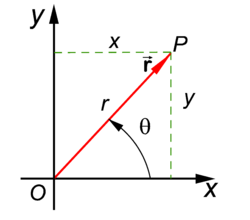Polar coordinates: Difference between revisions
Jump to navigation
Jump to search

imported>Anthony Argyriou (add direction angle is measured) |
imported>Paul Wormer No edit summary |
||
| Line 1: | Line 1: | ||
{{subpages}} | {{subpages}} | ||
[[Image: | [[Image: Polar coordinates .png|right|thumb|250px|Two dimensional polar coordinates ''r'' and θ of vector <math>\scriptstyle \vec{\mathbf{r}}</math>]] | ||
In [[mathematics]] and [[physics]], '''polar coordinates''' give the position of a vector <math>\scriptstyle \vec{\mathbf{r}}</math> in two-dimensional real space <math>\scriptstyle \mathbb{R}^2</math>. A Cartesian system of two orthogonal axes is presupposed. One number (''r'') gives the length of the vector and the other number (θ) gives the angle of the vector with the ''x''-axis of the Cartesian system (measured in the direction of the positive y-axis). | In [[mathematics]] and [[physics]], '''polar coordinates''' give the position of a vector <math>\scriptstyle \vec{\mathbf{r}}</math> in two-dimensional real space <math>\scriptstyle \mathbb{R}^2</math>. A Cartesian system of two orthogonal axes is presupposed. One number (''r'') gives the length of the vector and the other number (θ) gives the angle of the vector with the ''x''-axis of the Cartesian system (measured in the direction of the positive y-axis). | ||
==Definition== | ==Definition== | ||
Revision as of 04:52, 23 January 2008
In mathematics and physics, polar coordinates give the position of a vector in two-dimensional real space . A Cartesian system of two orthogonal axes is presupposed. One number (r) gives the length of the vector and the other number (θ) gives the angle of the vector with the x-axis of the Cartesian system (measured in the direction of the positive y-axis).
Definition
The polar coordinates are related to the Cartesian coordinates x and y through
so that for r ≠ 0,




